Puget Systems Obsidian: Solid as a Rock
by Dustin Sklavos on April 7, 2011 6:15 PM EST- Posted in
- Systems
- Intel
- Puget Systems
Application and Futuremark Performance
Given the stock Intel Core i5-2500K, reliance on Intel's integrated graphics, and standard Western Digital Caviar Black as both storage and data drive, it's not unreasonable to expect the Obsidian isn't going to set the world on fire with its performance numbers, especially not on charts comparing it to gaming desktops costing twice as much. Still, the i5-2500K is no slouch.
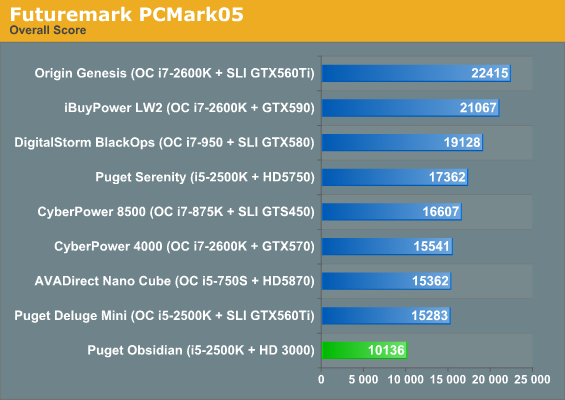
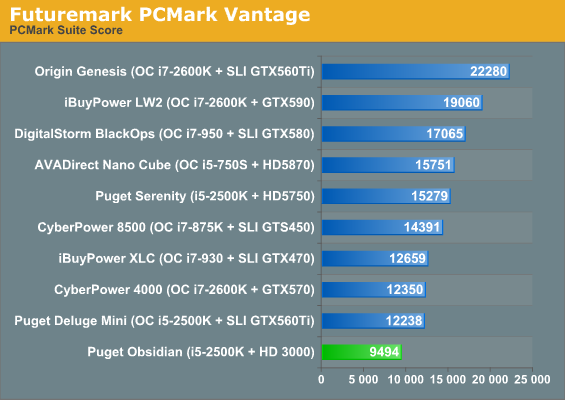
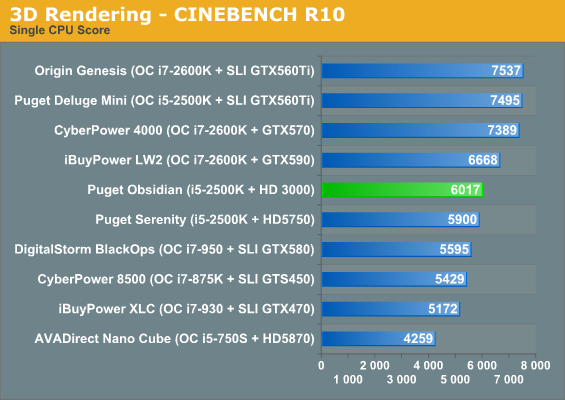

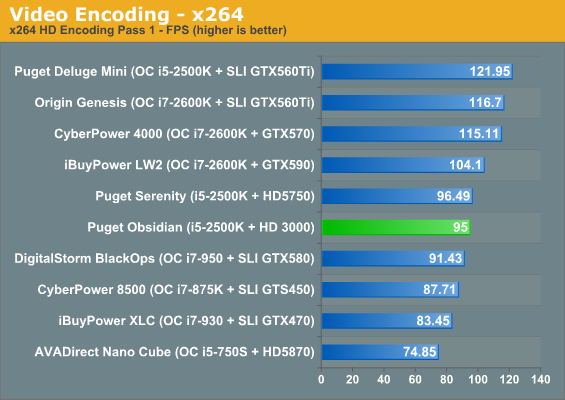

In any situation where the application can take advantage of Hyper-Threading, the i5-2500K has a tough time keeping pace. Overclocked Nehalem-class processors have a hard time keeping pace with it in less heavily threaded loads, but once Hyper-Threading kicks in they're able to gain traction. Meanwhile, PCMark continues to skew heavily towards systems with SSDs.
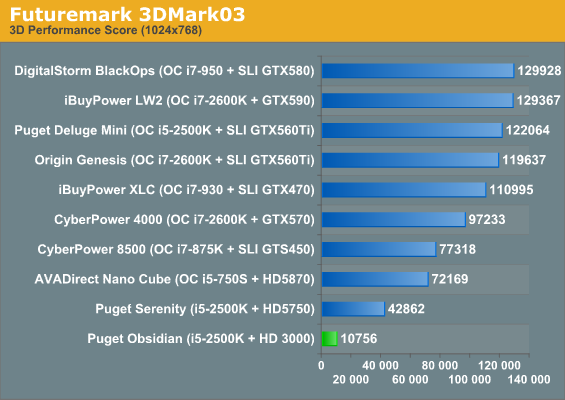
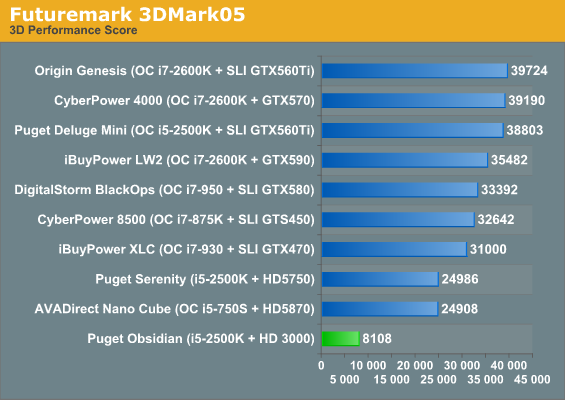
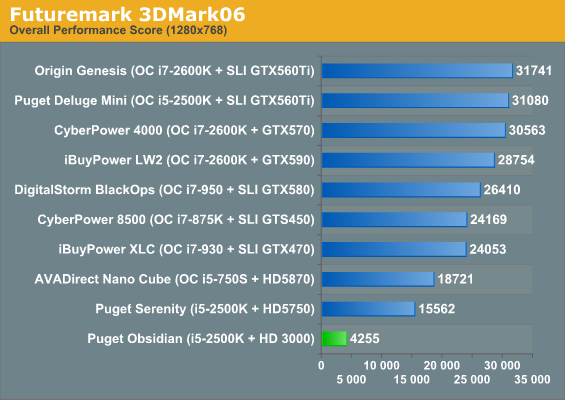
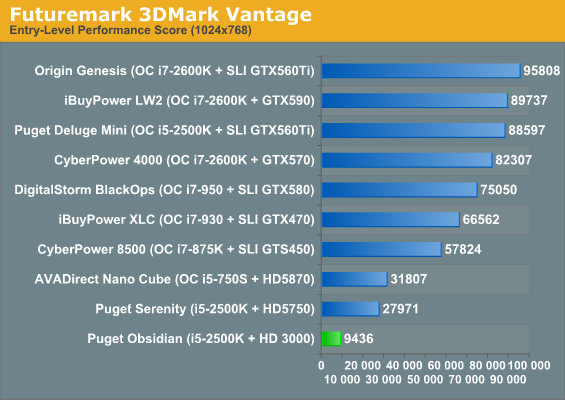
Given that the next slowest GPU on our charts is the capable AMD Radeon HD 5750, it's no surprise Intel's integrated graphics keep the Obsidian at the bottom of the pack. Anand's already gone into better detail about the HD 3000's performance than I ever could in his review of Sandy Bridge; it's not really worth running the Obsidian through our battery of gaming tests just to confirm that, no, the HD 3000 does not produce anything even remotely resembling playable performance in Metro 2033 at 1080p. I know some of you are crushed to learn that.










27 Comments
View All Comments
dawp - Saturday, April 9, 2011 - link
in most business environments I've been in, all the business critical apps are run of the server and very little is kept on the local machines, mostly personal settings and files. a raid setup for that is 1 more step and/or headache the IT department would have to take.erple2 - Sunday, April 10, 2011 - link
The business community has a server to store critical information, and essentially "dumb terminals" (well, slightly smarter than a true thin client) that are essentially "commodity" hardware. For that user, where a re-build costs nearly nothing (image from a central server via network at the touch of a button), and, you're good to go. All "critical" files (business files - proposals, documents etc) are stored in a collaboration area anyway, and that's backed up with RAID 5 or better, plus off site storage, and you only need the apps on the local machine.For that user, you don't need RAID on the local machines.
PWRuser - Friday, April 8, 2011 - link
"The configuration our Deluge Mini review unit shipped with (what) makes for an interesting comparison with the Origin Genesis we recently reviewed."flexcore - Friday, April 8, 2011 - link
Why couldn't they use a power brick for a machine like this that uses such little power? They would get great efficiency and no noise from it? I don't understand why low power office machines and other computers with low power computers don't use power bricks?Taft12 - Sunday, April 10, 2011 - link
They do. They're called laptops and many large companies provide laptops for most ro all employees.7Enigma - Tuesday, April 12, 2011 - link
Limited upgradability most likely. Remember while few there are custom options that would significantly increase the power draw of the system. I agree though that it should be an option if your build has <150w total system draw. For aesthetics they could still have the power brick inside of the case with just the cord coming out, but you'd get the benefits of the higher efficiency/no noise.MadMinstrel - Sunday, April 10, 2011 - link
I'm not sure what type of office use requires a quad core. Seems like overkill. The five uses of more than two cores are rendering, encoding, web and database servers, some types of scientific calculation and gaming. Machines like the Obsidian are unlikely to ever be faced with one of those. Anything I've missed?bobbozzo - Tuesday, April 12, 2011 - link
Developers - Visual Studio now supports multi-threaded compilation, and of course gcc has for years.bobbozzo - Tuesday, April 12, 2011 - link
Besides, Dell and HP are selling quad-core desktops nowadays.You can't even get a single-core Dell Latitude anymore in the 14" and above size.
shady28 - Sunday, April 10, 2011 - link
I haven't seen any system reviews on Anand or any of the enthusiast sites that I would consider an enterprise / corporate PC. Occasionally you'll get the corporate laptop - like a Dell E6410/20 or something along those lines, but never a corporate desktop.
Those, by and large, are the Optiplex series. If you want to see a real corporate desktop, look at the Optiplex 960, or HP Elite series desktops - or the HP thin clients.
By most enthusiast measures, there are simply well built underpowered PCs. Most of these are still selling with C2D E8400 or E8500 processors and integrated 4500 graphics.
That's all that's needed in 98% of the offices in corporate america.